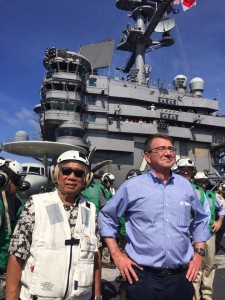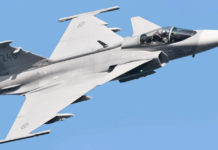
While Beijing has always encouraged every nation that they are not militarizing the West Philippine Sea (South china Sea) and mean no harm to its neighbors, the United States has tightened up its moves, announcing new plans and strategy to deploy a fleet of unmanned and armed submersibles drones into the disputed waterway.

US Defense Secretary Ashton Carter said amid a visit to the USS Stennis in the West Philippine Sea on Friday said, “Countries across the Asia-Pacific are voicing concern with China’s land reclamation, which stands out in size and scope, as well as its militarization in the South China Sea,”
Carter said that the Pentagon is perfecting “new undersea drones in multiple sizes and diverse payloads that can, importantly, operate in shallow water, where submarines cannot.”
The Pentagon strategy to spend as much as $8 billion throughout the following year on submarines, both manned and unmanned, yet the need will be on outfitting armed and self-ruling submersibles.
Shawn Brimley of the Center for a New American Security, a think tank, told Financial Times. that “The thought is that on the off chance that we were ever to get into a bust-up in the South China Sea, the Chinese would not know for sure what sort of capabilities the US might have.”
Brimley said, “This might have a deterrent impact on the potential for provocative behavior.”
Submersible drones are just like unmanned aerial vehicles that have the same advantages and capabilities. Without a crew, the unmanned craft can be made smaller and cheaper, while still housing sonar and other surveillance systems. The affordability allows the Pentagon to deploy devices in larger numbers.

The littler size additionally implies that the craft harder to detect. Unmanned submersibles could slip undetected into enemy waters for surveillance or assault.
“The utilization of undersea drones opens up a whole new area of capabilities,” Brimley said.
While the Pentagon is funneling large sums into submarine development, it is simultaneously developing a fleet of unmanned surface ships meant to counter both Beijing and Moscow. Created by the Defense Advanced Research Projects Agency (DARPA), the Sea Hunter has earned the nickname “ghost ship” for its ability to autonomously and clandestinely search the world’s oceans for submarines.

Peter Singer of the New America Foundation, a think tank based in Washington DC said: “We’re working on it because we’re deeply concerned about the advancements that China and Russia are making in this space.”
The United States has no claims in the region but their only aim is to freedom of navigation and overflight, though there are overlapping claims with our allies like the Philippines and Japan also with Vietnam, Indonesia, Taiwan, and Brunei. wherein China claimed almost 90% of the entire South China Sea and nearly $5 trillion international trade passes annually.















